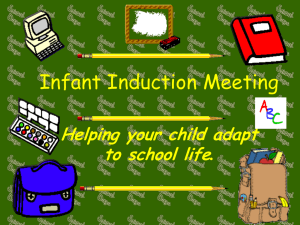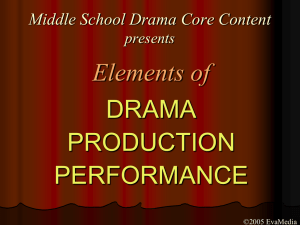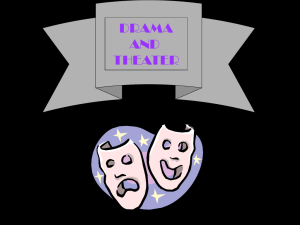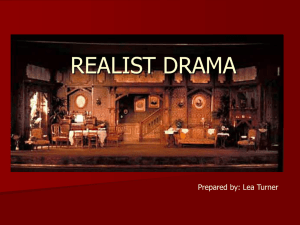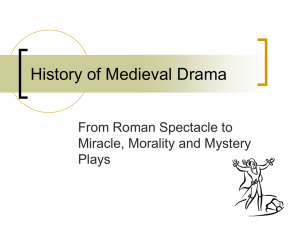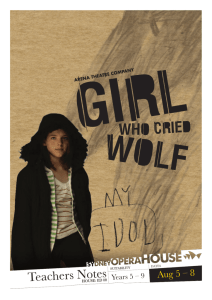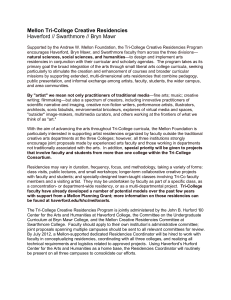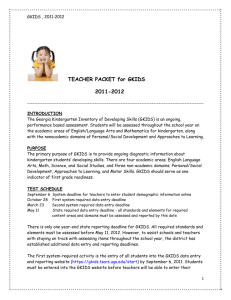Dr. Kruger`s Presentation
advertisement
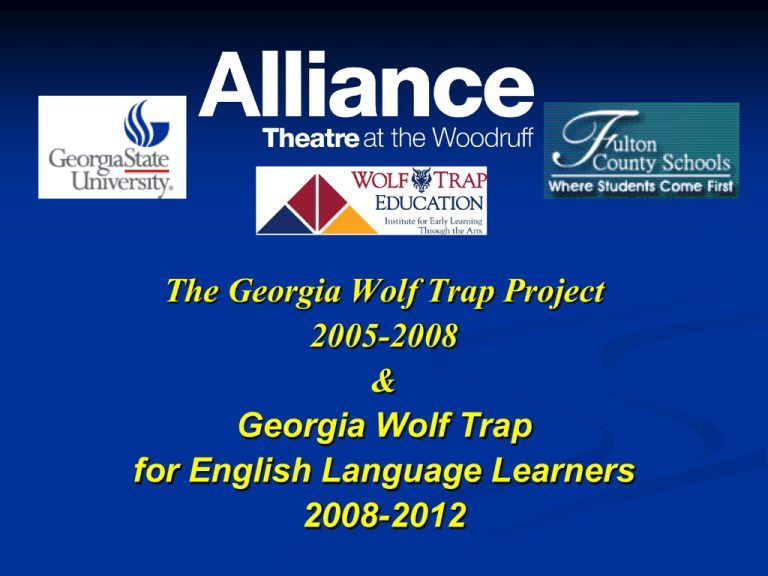
The Georgia Wolf Trap Project 2005-2008 & Georgia Wolf Trap for English Language Learners 2008-2012 A collaboration of Alliance Theatre, Fulton County Schools, and Georgia State University Funded (2005-2012) by the U.S. Department of Education Arts Education Model Development and Dissemination Program (AEMDD) AEMDD Criteria Discipline-specific arts instruction and Enhancement of academic achievement Low-income children Context of the Intervention Language development in early childhood predicts school performance. The “achievement gap” begins before the child’s first day of school. Low-income children begin Kindergarten with less than half the vocabulary of high-income students, challenging literacy development. Premises of the Intervention Social and communicative experiences that support the development of symbolic functioning are essential in early childhood. Pretend play, the developmental foundation of drama, is the child’s “first language.” Joint pretense and story sharing can unpack language. Drama engages children’s emotions and intellect, transcending culture and class. 1st Project – 2005-8 All Kindergarten classes in 6 schools Random assignment of low-income schools to conditions; pre-intervention/post-intervention Professional learning opportunities for Kindergarten teachers in summer and fall; artists and teachers collaboratively infuse drama into language lessons in January and February Sample Characteristics N= 545 students 36% special needs 71% qualified for free or reduced lunch 94% African American Sample Starting Point 100 PPVT 90 80 Oral Vocabulary 70 60 Grammatic Understanding Sentence Imitation 50 40 30 20 10 0 Pretest Percentile Rank Hypotheses Intervention students will show more improvement than control students in Language Development Writing (near transfer) Academic Achievement (far transfer) Language Development: Syntax 55 Pre Post 45 35 Control Intervention Writing: Quantity 15 10 Pre Post 5 0 Control Vocabulary Intervention 4 3 Pre Post 2 1 0 Control Intervention Sentences Writing: Quality 20 Theme Structure Resolution 10 0 Control Intervention Percentage of Students with Improvement over Time Report Card Grades First Grade (Cohorts 1& 2) Special Needs CRCT Scores First Grade (Cohorts 1& 2) Special Needs Contributions Drama = Developmental Appropriateness Helping children find their voice—childcentered education supports symbolic development Authentic, meaningful activity in a languagerich and emotionally engaging context Usefulness of this approach for development and learning Next? Georgia Wolf Trap for English Language Learners Context In 2008 Latino students were the largest minority in American schools - 11 Million or 22% Facing an educational crisis: Less likely to be enrolled in pre-K programs Twice as likely to be retained Highest dropout rates—18.3 % in 2008 (compared to the total rate of 8%). White House Initiative on Educational Excellence for Hispanics October 19, 2010 White House Initiative advocates enhanced preK preparation and K-12 educational reforms for Latino students Fulton County was the third most populous Latino community in GA; over 20% living in poverty; many students with limited English proficiency FC schools are English only Pull out/push in services in K=45 minutes/day Achievement gap in 2008 70% of Fulton County ELL K students finished the year with low English proficiency 33%were below academic expectations after 1st grade only 39% passed all areas of GA high school graduation test Language minority and low income status = double risk for academic failure Background: Quantity of exposure to English in class does not predict acquisition; quality of engagement with English does (Snow et al., 1998). Hypothesis: an emphasis on meaningful communication experiences will support acquisition. Professional development for teachers as before —teaching artists as coaches, November-March Drama activities—“improvised guided enactment”—can disambiguate language Story sharing; analyzing and enacting; retelling and reflecting Elements in common with ESOL strategies language embedded in meaningful contexts using the senses, props, facial expressions physicalization, repetition incorporating students’ ideas Design Paired Cluster/random assignment of schools to conditions (6 schools; all K classrooms) Random selection of research participants (all ELL) Schools range from 39-68% ELL Participants 514 Kindergartners over three years 200912 All qualified as ELL, all speak Spanish at home 97% qualified for free or reduced lunch All regular education students Measures District ESOL Screening Measures - English WAPT-L/S - at registration Kindergarten ACCESS for ELLs - January/February WMLS-R - two languages - pre (Sept & Oct) and post (April & May) Story Writing - English only - pre and post G-KIDS - first grade readiness test - English only Significance Testing: Treatment Received All three years of professional learning (N=12 teachers) Control group (N=31 teachers) Total Oral English 468 466 464 462 460 Control Intervention Story Writing - Fluency 20 Control Intervention 15 10 5 0 Words Sentences Story Writing - Quality 0.2 Control Intervention 0.15 0.1 0.05 0 Emotion Dialogue Academic Achievement GKIDS Control 70 Intervention 60 50 40 30 Language Arts Academic Achievement GKIDS Control Intervention 70 60 50 40 30 Mathematics What We Learned Drama = links among emotion, meaning, words Brief intervention —> noteworthy effects in language and mathematics Enhanced language engagement (versus exposure or drill) What is driving all this? Professional Learning Professional Learning Key to Positive student outcomes and true reform PL Process PL is most effective when teachers are taught as they would teach Workshops employed Wolf Trap strategies PL takes time Summer study Opportunities throughout year to observe, coteach Three years duration Evaluation Sources Teachers’ evaluations Teaching artists’ evaluations Focus groups Classroom observations Teachers’ self-assessment surveys Performance Measures 100% developed lessons integrating drama during the residencies 95% employed drama management techniques 95% used Best Practices in Drama during the residencies 90% indicated they would develop lessons using Best Practices in Drama after the residencies ended What Did You Learn? “I learned to put down my guard and try new things ‘dramatically’ with the students.” “I learned how to effectively use my body and my voice to tell a story.” “I learned how to build drama into my literacy instruction.” “I learned how to incorporate Wolf Trap ideas in other areas of teaching.” PL Conclusions Teachers recognize the learning taking place in their students – socially, emotionally, linguistically, and cognitively. Teachers applaud the PL model used, especially the Teaching Artist as coach in the classroom. Over time, teachers increasingly used the strategies throughout their teaching. It Makes a Difference Oral Language Story Writing: Fluency 18 466 16 14 464 12 462 Control Some Professional Learning Three Years Professional Learning 10 Control Some Professional Learning Story Writing: Quality 16 14 12 10 8 6 4 2 0 Control Some Professional Learning Three Years Professional Learning Three Years Professional Learning Acknowledgements Fulton County Schools Alliance Theatre Education Department Jackie Gray, Carol Jones, Michele Mummert, Denise Jennings, Jes Booth GSU: Audrey Ambrosino, Brooke Bays, Judy Orton, Lynda Kapsch, Heather Smith, Nicole Lorenzetti, Carol Ashong, Josephine Lindsley, Callie Reeves, Daniel Medina, Kareema Spells, Peter Samuelson, Elizabeth McGarragh, Macy Strickland, Lisa Quick, Joanna Sherwood, Beatrice Moreno, Araceli Santa Cruz, Inez McDaniel, Renzo Gobea, Brandi Harper, Kathryn Taylor, Meghann Griffin, Rachael Kaplan, Emily White, Billy Thompson Thank you!

